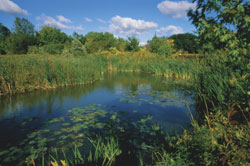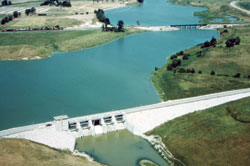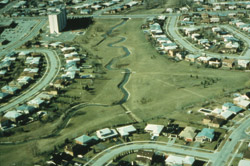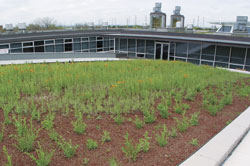The devastating impact of Hurricane Hazel in 1954 was a mobilizing force in bringing a regional approach to flood control and water management in Ontario.
A more coordinated approach between conservation authorities, local municipalities and the province took form after Hazel, and today these organizations play a significant role in the protection of life and property from natural hazards, such as flooding.
After Hazel, the provincial government amended the Conservation Authorities Act to enable an authority to acquire lands for recreation and conservation purposes and to regulate that land for the safety of the community.

Forests and wetlands are protected and more trees are planted. They help to store runoff to reduce flooding.
In 1959, a comprehensive Plan for Flood Control and Water Conservation was finalized by the Metropolitan Toronto and Region Conservation Authority ( MTRCA ). It included the proposed development of large dams and major flood control channels, and the initiation of an erosion control program. In addition, 7,200 acres of land were identified for acquisition.
In 1960, the Lands Acquisition Program was implemented as the initial stage in the MTRCA flood control plan. The intent of this program was to transfer the liability of floodplain land from private hands to the authority and to acquire lands necessary for the construction of flood protection works.
The second stage of the MTRCA flood control plan, was the Flood Control Works Program. The intent of this program was to construct as many structures that were necessary to control flooding. The works consisted of dams, reservoirs, channel improvements and other infrastructure.

Flood control dams store water during a flood, and release it more gradually after the flood has passed.
While some of the initial flood protection planning and implementation began within the MTRCA, as one of the most directly affected conservation authority’s by Hurricane Hazel, similar flood protection activities also began soon afterward within other conservation authorities throughout the province.
The development and implementation of new provincial flood plain regulations acted as a complementary third stage in obtaining the goals of the flood control plan. These regulations allowed for the control of future development and inappropriate land use activities in flood-hazard areas. As well, a Flood Forecasting and Warning Program was designed to monitor watershed conditions including snow, precipitation and flows, as well as to issue flood alerts to municipalities when conditions warranted.

Regulations restrict new development in floodplains, allowing rivers to flow naturally and reducing the risk to people and their property during flooding.
| Conservation Authorities Act |
|
The Conservation Authorities Act was legislated by the provincial government in 1946 in response to the concern by agricultural, naturalist and sportsmen's groups, that the renewable natural resources of the province were in an unhealthy state. Although the responsibility for managing natural resources lay with the province, the scale of erosion and water problems was such that it required a new approach, and when a number of municipal councils agreed to become involved, this spirit of cooperation led to the passage of the Conservation Authorities Act in 1946. Three fundamental concepts of this new approach were embodied in the Act: local initiative, cost sharing and watershed jurisdiction. The Conservation Authorities Act provided the means by which the province and the municipalities of Ontario could join together to form a conservation authority within a specified area—the watershed—to undertake programs for natural resource management. Today there are 36 conservation authorities in Ontario.
It is only possible to achieve the many goals in managing Ontario's watershed resources, with the help and cooperation of conservation authorites' many partners and stakeholders; foresters, engineers, ecologists, geologists, economists, municipal members, volunteers, farmers, developers, educators and citizens just to name a few. Over time, conservation authorities have become involved in a wide range of activities and responsibilities, depending on the environmental concerns of local residents, member municipalities and the province. Each conservation authority's watershed management program is geared to its local needs and, therefore, the authority may or may not implement all programs.
|
| Conservation Authorities' Range of Program Development |
Ontario's conservation authorities have achieved an enviable record in wetland protection and management, conservation education, provision of local and regional recreational opportunities, forest management and heritage conservation.
|
Several flood control facilities were significantly upgraded or built following Hurricane Hazel. Gauging stations became operational and a rainfall observer network was organized, providing the ability to forecast and warn against potential flooding in the area. Operational practices were also designed to respond immediately to changing conditions.
There are three important components to flood management and forecasting in which the conservation authorities are responsible:
Prevention. Informing planners and the general public about the risks of flooding to promote proper land use planning, preventing people from living and/or working in flood-prone areas. Conservation authorities are responsible for predicting flows and water levels within their watersheds, operating flood control structures, such as dams and disseminating flood warnings to local municipalities and agencies.
Protection. In order to protect against flooding, conservation authorities have constructed and maintain protective infrastructure, such as dams and dykes, or purchase lands located in hazardous areas. Stream gauges, weather stations, surveys of snow conditions, meteorological forecasts and computer models are used to forecast potential floods.
Emergency Preparedness and Response. Conservation authorities work with the Ministry of Natural Resources (MNR) to provide advice to municipalities for the preparation of flood contingency plans and to provide advice during the emergency response process. In Ontario, conservation authorities, and the MNR are responsible for forecasting where and when flooding is likely to occur and issuing flood alerts and warnings to local municipalities, the media, police and school boards. To facilitate this activity, conservation authorities and the MNR work closely with Environment Canada, Meteorological Services, who provide the weather information necessary to make the flood forecasting systems function effectively.
These advance warnings allow municipalities and other government agencies to put emergency response plans into operation, to evacuate communities and remove portable property from flood-susceptible areas. Advance warnings also notifies the public of developing or ongoing unsafe river and lake conditions, and allows them to take precautions.
There are four different flood messages:
FLOOD ADVISORY: notifies that the potential for flooding exists within specific watercourses and municipalities.
FLOOD WARNING: notifies that flooding is imminent or occurring within specific watercourses and municipalities.
FLOOD SAFETY BULLETIN: notifies that unsafe lake, river and channel conditions exist.
WATERSHED CONDITIONS BULLETINS: notifies of anticipated watershed conditions.
In Ontario, the flood risk area is defined by the flooding hazard limit. Depending on location in the province, the flooding hazard limit is determined by the 100-year peak flow, a regional storm or the highest observed flood. In some communities, the two-zone approach is used, with a floodway and flood fringe being designated. Ontario has over 270 communities that are 'designated flood areas'. Is your property in a 'designated area' that is subject to recurrent and severe flooding? Find out at www.ec.gc.ca/water/en/manage/flood/e_ont.htm
